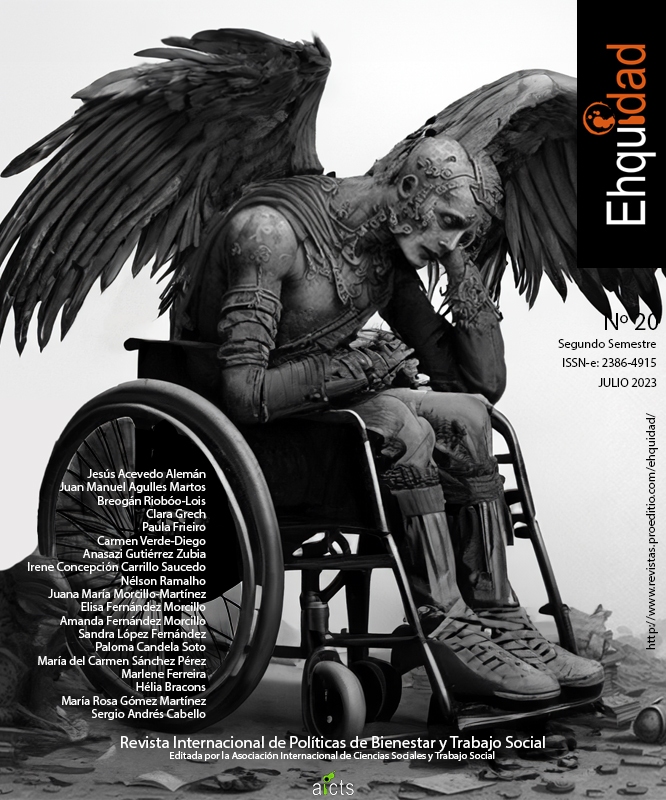Exploración del enmascaramiento en mujeres autistas y la presencia de sintomatología ansiosa y depresiva.
DOI:
https://doi.org/10.15257/ehquidad.2023.0014Palabras clave:
Autismo, género, enmascaramiento, depresión, ansiedadResumen
El autismo en mujeres es un fenómeno de investigación relativamente nuevo, teniendo en cuenta que las investigaciones respecto al tema han estado centradas en hombres desde el inicio (Gould, 2017), relativamente hace poco que se tuvo en cuenta la existencia de las mujeres dentro del espectro autista, teniendo como consecuencia que las mujeres sean menos diagnosticadas aún en niveles similares de rasgos autistas (Leedham, et. al., 2019), además las expectativas sociales relacionadas al género han hecho que las mujeres autistas sean más propensas a enmascarar sus rasgos que los hombres autistas (Hull, et. al., 2019), lo anteriormente mencionado se añade a las razones de un diagnóstico tardío en mujeres. El objetivo del presente estudio fue conocer el nivel de enmascaramiento en una población de 37 mujeres autistas sin discapacidad intelectual y su edad de diagnóstico, así como presencia de síntomas de depresión y ansiedad. El estudio fue de tipo descriptivo y de corte transversal. Se realizó una entrevista semiestructurada para identificar datos sociodemográficos y detalles de diagnóstico. Se elaboró un cuestionario para identificar el enmascaramiento autista. Se aplicaron el Inventario de Ansiedad de Beck (BAI; Beck 1988) y el Inventario de Depresión de Beck (BDI-2; Beck, 1996). Los resultados obtenidos indican que el 91.9% enmascaran los rasgos autistas; además, el 2.7% presenta diagnóstico de depresión, el 8.1% ansiedad y el 78.4% con depresión y ansiedad.
Descargas
Citas
Asociación Psiquiátrica Americana - APA. (2013). Manual diagnóstico y estadístico de trastornos mentales (5th ed.). https://bit.ly/3oByxHW
Beck, A. T., Steer, R. A., & Brown, G. (1996). Beck Depression Inventory–II (BDI-II) [Database record]. APA PsycTests. https://doi.org/10.1037/t00742-000
Beck, A. T., Epstein, N., Brown, G., & Steer, R. A. (1988). An inventory for measuring clinical anxiety: Psychometric properties. Journal of Consulting and Clinical Psychology, 56(6), 893–897. https://doi.org/10.1037/0022-006X.56.6.893
Bonney, E., Abbo, C., Ogara, C., Villalobos, M. E., & Elison, J. T. (2021). Sex differences in age of diagnosis of autism spectrum disorder: Preliminary evidence from Uganda. Autism Research, 15(1), 183–191. https://doi.org/10.1002/aur.2645
Centers for Disease and Control prevention - CDC. (2020). Data & Statistics on Autism Spectrum Disorder. https://www.cdc.gov/ncbddd/autism/data.html
Dean, M., Harwood, R. & Kasari, C. (2016). The art of camouflage: Gender differences in the social behaviors of girls and boys with autism spectrum disorder. Autism, 21(6), 678–689. https://doi.org/10.1177/1362361316671845
Hull, L., Mandy, W., Lai, M.-C., Baron-Cohen, S., Allison, C., Smith, P., & Petrides, K. V. (2018). Development and Validation of the Camouflaging Autistic Traits Questionnaire (CAT-Q). Journal of Autism and Developmental Disorders, 49(3), 819–833. https://doi.org/10.1007/s10803-018-3792-6
Hull, L., Lai, M., S. Baron-Cohen, Allison, C., Smith, P. L., Petrides, K., & Mandy, W. (2019). Gender differences in self-reported camouflaging in autistic and non-autistic adults. Undefined; https://www.semanticscholar.org/paper/Gender-differences-in-self-reported-camouflaging-in-Hull-Lai/3b9caace6f44aefaccc1064510b1ff7649fe8633
Hull, L., Petrides, K. V., & Mandy, W. (2020). The Female Autism Phenotype and Camouflaging: A Narrative Review. Review Journal of Autism and Developmental Disorders, 7(4), 306–317. https://doi.org/10.1007/s40489-020-00197-9
Lai, M. C. & Baron-Cohen, S. (2015). Identifying the lost generation of adults with autism spectrum conditions. The Lancet Psychiatry, 2(11), 1013–1027. https://doi.org/10.1016/s2215-0366(15)00277-1
Lai, M. C., Lombardo, M. V., Auyeung, B., Chikrabarti, B. y Baron-Cohen, S. (2015). Sex/gender differences and autism: Setting the scene for future research. Journal of the American Academy of Child and Adolescent Psychiatry (JAACAP).
Lai, M. C., Lombardo, M. V., Ruigrok, A. N., Chakrabarti, B., Auyeung, B., Szatmari, P., Happé, F., & Baron-Cohen, S. (2016). Quantifying and exploring camouflaging in men and women with autism. Autism, 21(6), 690–702. https://doi.org/10.1177/1362361316671012
Leedham, A., Thompson, A. R., Smith, R., & Freeth, M. (2019). “I was exhausted trying to figure it out”: The experiences of females receiving an autism diagnosis in middle to late adulthood. Autism, 24(1), 135–146. https://doi.org/10.1177/1362361319853442
McCrossin, R. (2022). Finding the True Number of Females with Autistic Spectrum Disorder by Estimating the Biases in Initial Recognition and Clinical Diagnosis. Children, 9(2), 272. https://doi.org/10.3390/children9020272
Milner, V., McIntosh, H., Colvert, E., & Happé, F. (2019). A Qualitative Exploration of the Female Experience of Autism Spectrum Disorder (ASD). Journal of Autism and Developmental Disorders, 49(6), 2389–2402. https://doi.org/10.1007/s10803-019-03906-4
National Autistic Society - NAS. (2022). Autistic women and girls. Autism.org.uk. https://www.autism.org.uk/advice-and-guidance/what-is-autism/autistic-women-and-girls
Perry, E., Mandy, W., Hull, L., & Cage, E. (2021). Understanding Camouflaging as a Response to Autism-Related Stigma: A Social Identity Theory Approach. Journal of Autism and Developmental Disorders. https://doi.org/10.1007/s10803-021-04987-w
Sanz, J., García-Vera, P., & Fortún, M. (2012). EL “INVENTARIO DE ANSIEDAD DE BECK” (BAI): PROPIEDADES PSICOMÉTRICAS DE LA VERSIÓN ESPAÑOLA EN PACIENTES CON TRASTORNOS PSICOLÓGICOS. Behavioral Psychology / Psicología Conductual, 20, 563–583. https://www.behavioralpsycho.com/wp-content/uploads/2019/08/05.Sanz_20-3oa.pdf
Sanz, J., Gutiérrez, S., Gesteira, C., & Paz García-Vera, M. (2014). CRITERIOS Y BAREMOS PARA INTERPRETAR EL “INVENTARIO DE DEPRESIÓN DE BECK-II” (BDI-II). Behavioral Psychology / Psicología Conductual, 22, 37–59. https://www.behavioralpsycho.com/wp-content/uploads/2019/08/03.Sanz_22-1oa.pdf













